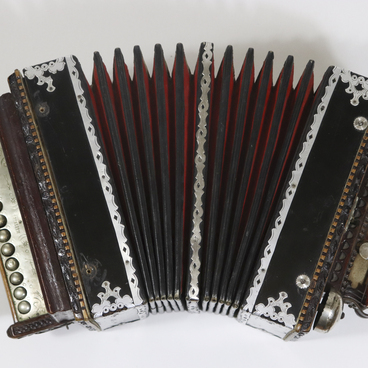The duck salt cellar is interesting in terms of its form and the technique used to produce it. It was made in the form of a swimming bird that has a small head and a wide, flat tail. The artisan made the eyes of the duck from reddish brown beads. The sliding back cover is secured with a metal bolt that replaced a worn-out wooden pin. The salt cellar was made with simple tools: an ax and a knife. First, the form was cut with an ax, and that was followed by a combination of chiseling and carving. This kind of salt cellar was chiseled out from the tree butt - the thick part of the trunk right above the root system and rhizome. The carver who created the product on display not only knew the properties of wood, and had mastered the technique of carving, but also had artistic taste and a sense of form. Without copying nature, the artisan outlined only the main, typical features of a swimming bird.
The salt cellar was brought in 1927 by museum staff Tatyana Akimova and Valeriy Vorobyov from an expedition to the village of Russkaya Norka, which is in Petrovsky District in Saratov Province. The product is made using an old chisel carving technique, which distinguishes it from later salt cellars in the form of chairs, which were turned on a lathe. Researchers believe that to give the wood a dark tone, and to protect it from rot, insects, and increase its durability, the salt cellar was cured over a fire and then soaked in hempseed oil.
Salt cellars in the form of swimming birds were done for Russian everyday life in large workshops in Russia’s northern provinces. There were no workshops like this in Saratov province, but the villages of Verkhozim, Sinodskoye, and Lubyanka, which were founded by settlers from northern regions where woodcarving was well-developed, were located twelve kilometers from the village of Russkaya Norka. These villages had household items that were decorated with carving: icon cases, cabinets, spinning benches, and sleighs. It is most likely that the duck salt cellar was done as an order by transplants from Russia’s northern provinces.
Ethnographers have noted that in the last decades of the 19th century, and even at the very beginning of the 20th century, the salt cellar was the utensil that had the most honored spot on peasants’ tables. It played a major role during wedding ceremonies, and was part of the bridal dowry. Vessels in the shape of a bird carried additional symbolic meaning, because the bird was popularly considered to be the protectress of family happiness and well-being.
The salt cellar was brought in 1927 by museum staff Tatyana Akimova and Valeriy Vorobyov from an expedition to the village of Russkaya Norka, which is in Petrovsky District in Saratov Province. The product is made using an old chisel carving technique, which distinguishes it from later salt cellars in the form of chairs, which were turned on a lathe. Researchers believe that to give the wood a dark tone, and to protect it from rot, insects, and increase its durability, the salt cellar was cured over a fire and then soaked in hempseed oil.
Salt cellars in the form of swimming birds were done for Russian everyday life in large workshops in Russia’s northern provinces. There were no workshops like this in Saratov province, but the villages of Verkhozim, Sinodskoye, and Lubyanka, which were founded by settlers from northern regions where woodcarving was well-developed, were located twelve kilometers from the village of Russkaya Norka. These villages had household items that were decorated with carving: icon cases, cabinets, spinning benches, and sleighs. It is most likely that the duck salt cellar was done as an order by transplants from Russia’s northern provinces.
Ethnographers have noted that in the last decades of the 19th century, and even at the very beginning of the 20th century, the salt cellar was the utensil that had the most honored spot on peasants’ tables. It played a major role during wedding ceremonies, and was part of the bridal dowry. Vessels in the shape of a bird carried additional symbolic meaning, because the bird was popularly considered to be the protectress of family happiness and well-being.



